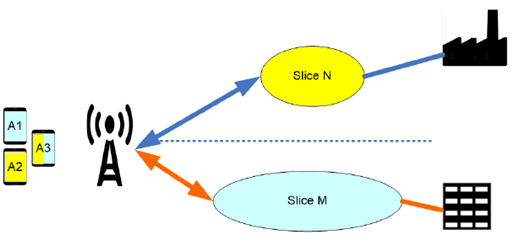Content for TR 22.835 Word version: 18.2.0
5.3 Service scenario for disjoint network slices
5.3.1 Description
5.3.2 Pre-conditions
5.3.3 Service Flows
5.3.4 Post-conditions
5.3.5 Existing features partly or fully covering the use case functionality
5.3.6 Potential New Requirements needed to support the use case
...
...
5.3 Service scenario for disjoint network slices p. 14
5.3.1 Description p. 14
As more network slices are deployed, it is likely that each UE can access to multiple network slices. While some network slice services can be simultaneously provided to the UE, there can be network slices which cannot simultaneously provide services to the UE. This is because there are multiple related factors for a network slice, e.g., enterprise use vs personal use, isolation requirement, general public use vs public safety use, frequency limitation, location restriction, etc.
5.3.2 Pre-conditions p. 14
Network slices are deployed by same geographical location but they are incompatible by configuration. Figure 5.3.2-1 shows the use case scenario where a RAN node connects to two network slices simultaneously. Slice M and Slice N have no shared/common core network nodes supporting these network slices due to network resources incompatibility in 5GC. For example, Slice M is used for public security and Slice N is used for Internet access. In the 5GC, dedicated network resources and network functionalities are separately customised for public security emergency service and video service to meet the isolation requirements, which ensures the independence of core network resources between different network slices. Accordingly, the two network slices are isolated and cannot be simultaneously provided to the UE.

In this Figure, it is assumed that
-
Subscription and configuration:
- UE A1 and A3 are authorized to access Slice M.
- UE A2 and A3 are authorized to access Slice N.
- For UE A3, it is configured which applications use which network slices.
-
Deployment:
- Slice N and Slice M are deployed at the same geographical location. Slice N and Slice M are isolated. Due to the network resources incompatibility in 5G core network, there are no shared/common core network nodes supporting the Slice N and Slice M.
- NG-RAN is able to connect to both Slice M and Slice N.
- Slice M and Slice N are provided by the same PLMN.
5.3.3 Service Flows p. 15
Following is the service flow for UE A1, A2 and A3 when the signaling from these UEs is initially routed toward nodes managing Slice N:
- UE A1, A2 and A3 select the NG-RAN and start registration.
- Network slices provide connectivity services to UE A1, A2 and A3.
- While the UE A3 is connected to Slice N, Slice M cannot provide the connectivity service to UE A3. The user traffic applicable to Slice N is transported.
- Later, user traffic configured to use slice M is generated in UE A3. While the same NG-RAN is used, the traffic is switched to Slice M.
- If the user prioritizes applications configured to use Slice N, as soon as applications configured to use Slice M finish, the UE A3 needs to move back to Slice N, to minimize the latency.
5.3.4 Post-conditions p. 15
UE A1 is connected to Slice M.
UE A2 is connected to Slice N.
UE A3 switches between Slice N and Slice M, depending on e.g. ongoing applications.
5.3.5 Existing features partly or fully covering the use case functionality p. 15
There are related requirements on change of network slices based on services, as defined in clause 6.1.2.2 in TS 22.261:
The 5G system shall allow the operator to assign a UE to a network slice, to move a UE from one network slice to another, and to remove a UE from a network slice based on subscription, UE capabilities, the access technology being used by the UE, operator's policies and services provided by the network slice.
There are related requirements on impacts on other network slices caused by traffic and services from one network slice, as defined in clause 6.1.2.2 in TS 22.261:
Traffic and services in one network slice shall have no impact on traffic and services in other network slices in the same network.
Based on clause 6.1 of TS 22.261 network slicing, the following service requirement is supported:
The 5G system shall enable a UE to be simultaneously assigned to and access services from more than one network slice of one operator.
5.3.6 Potential New Requirements needed to support the use case p. 15
The following new requirements can be derived from this use case:
[PR.5.3.6-1]
For a UE authorized to access multiple network slices of one operator which cannot be simultaneously used by the UE (e.g. due to radio frequency restrictions), the 5G system shall be able to allow the UE to access the most suitable network slice (e.g. based on the ongoing applications).
[PR.5.3.6-2]
For a UE authorized to access to multiple network slices of one operator which cannot be simultaneously used by the UE (e.g. due to radio frequency restrictions), the 5G system shall support the minimized interruption when the UE changes the access from one network slice to another network slice. (e.g. based on changes of active applications).